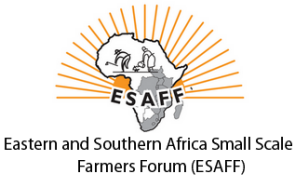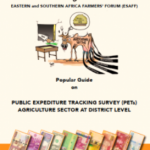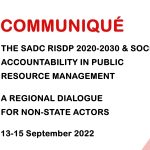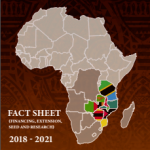All farmers wake up!
All farmers wake up!

A diary of Moses Shaha who travelled from the Coastal town of Mombasa, Kenya to the Mountains of Central Africa, Burundi
Moses Shaha is ESAFF Secretary General, he is a farmer from Kilifi, Kenya he has travelled a thousands of miles for the course of small scale farmers.
In 2002 He travelled all the way by road from his home town Kilifi, Mombasa via Nairobi to Johannesburg, South Africa. That was during the Word Social Sustainable Development summit.
Since then (2002) Moses has meandered East, Southern and Central Africa mobilising small scale farmers. Many times he was stopped at the borders and forced to pay something for him to get through.
So here is a story from his most recent trip from Mombasa all the way through Uganda, Rwanda and Burundi. His journey and what he saw, felt and tasted shows that small scale farmers are still marginalised, exploited, and not given rightful space, voices in budgeting processes, price setting and many others. It seems market economy is only for manufactured goods and not agricultural produce! To overcome all these – farmers must speak for themselves!
Kindly join him in his 13 days diary…
· Getting off … Destination Kampala Uganda,
1. 1st Day-
1st May 2009 – I left Kilifi for Nairobi by the night coach to start my first leg of the expected 13 day excursion in the three countries.
2. 2nd Day-
2nd May ’09 – I arrived in Nairobi at 5.30 am and scout for a suitable bus for Kampala in Nairobi. I put up in Nairobi. While here, I take the opportunity to visit Nairobi Cuts offices to drum up ESAFF support for its district based programme support to grassroots groups.
3. 3rd Day-
3rd May ’09 – I bought a seat for the trip to Kampala by Kampala Coach. I eventually depart for the 10 ½ hrs trip at 9.00 pm.
4. 4th Day-
4th May ‘09 – I arrived in Kampala the next morning at 9.30 am. I contact my hosts who arrange to have me picked up by taxi. Pick Nancy on way to the hotel. We both agree to have me picked from hotel to the ESAFF Uganda secretariat at 12.00 mid day so as to have lunch together before we settle down to work on the ESAFF Mission Objectives.
Picked from hotel to ESAFF Uganda secretariat. Have lunch, across the road at a local joint, with my hosts, Hakim-EsaffUganda Chair, and Nancy, the Coordinator. Back at the secretariat, I explain the gist of my visit. Since the questionnaire was fore sent before my arrival, we start to go through the programme and the questionnaire led by Hakim. The explanations get more interesting and we both decide not to hurry the responses coming from the hosts. We reach half way by the close of the day at 6.00 pm.
For the next day, we agree to start the guided field visit to Mukono District, a member of Esaff Uganda and then come back to the secretariat to complete the questionnaire which was the basis of my visit.
· A success stories of environmental activist in Uganda
5. 5th Day-
5th May ’09 – Am picked from the hotel at 8.30 am, then pick Nancy and head for Mukono Town in Mukono District. We are joined by both Irene, the Esaff Uganda advocacy officer and Hakim. We both pay a courtesy visit to the Executive Director of Uganda Environmental Education Foundation, Mr. Ssenyonjo Nicholas who warmly welcomes me and ESAFF Regional to Uganda. He applauds the decision of the ESAFF regional executives to carry out such visits. He further commends periodic visits to give encouragements and advice on the direction so desired by the farmers in their quest for self organization. He says the high expectations from ESAFF members are just too overwhelming as indicated of ESAFF being a farmers’ buzz word. This is due to the boring lifestyles of being in poverty situation all their lives. After my explanation of the reason of my visit, Mr. Nicholas also explains that UEEF is a close collaborating partner of ESAFF Uganda. The two organizations agreed to work together on a wide range of issues that are of interest to their members especially on the protection of the environment. Currently they are putting in place programmes that are anticipated to reverse global warming by planting 30,000,000 trees in both the countryside and in urban settings. The cleaning of river ways and protection of water catchment points is also in their priority. One notable achievement was the vigorous lobbying with other interested organizations in the preservation and protection of the Mabira Forest water tower, which led to a public national action plan to stop the government to sell and destroy the forest to private investment. They are also lobbying a few parliamentarians to drafting a bill that will protect the environment from the menace of the careless disposal of polythene bags that have many a time affected their livestock.
· Farmers and Budgeting process in Uganda
· The national Cake not for everyone in Uganda, where are the farmers
After the signing of the visitors’ book, we bid our hosts goodbye and are joined by Hakim on our way to Ntenjeru’s Piggery, 15 km deep in Mukono. It is co-sponsored by the National Agricultural Advisory Services – NAADS government programme in Mukono District. We spend ¾ of the day at Ntenjeru’s farm, learning of his success story. (Ntenjeru inherited his farm from his late father as the last born of the family as his two elder brothers who had been given other farms live elsewhere). Ntenjeru is the chairman of his group and recently nominated the leading meritorious good practice farmer in his district. He has 14 acres of land, enough to subdivide into smaller plots to plant various crops in one season. He grows bananas, coffee, maize, papaws, sweet peppers, hot peppers, tomatoes, cassava, carrots, onions and a few chewing sugar canes.) We take pictures before touring one part of his maize demonstration farm that he has planted part with farmyard manure and another section without, whose stark difference is seen with the fast growth of the maize crop that was planted with manure.
We later discuss around the following:
i). Genetically Modified Organisms,
ii). Extension Services Delivery,
iii). Farmers participation and involvement in the national budget process,
iv). His views on the relevancy of ESAFF now and in the future.
On the budgeting process, Ntenjeru reiterates of the need to have transparency on the process as the process is being abused and or taken advantage of by some people who are and are usually favoured, though they present issues that are not relevant to the immediate needs of the farmers in the district.
Their pressing issues are always deferred to the next budget process. Some of the issues are:
a). The costs of upgrading of the feeder roads from the farmers’ farms to the main tarmac trunk roads leading to the markets,
b). The improvement of Primary grade Schools,
c). Sinking of more water boreholes as present ones are too far apart,
d). Addition of dispensaries which are ill equipped with too few staff,
e). Supply of agricultural inputs (pesticides, seeds, fertilizers, etc, ) in the area,
e). Subsidizing of the costs of extension services to farmers, etc.
f). Market access and favourable price identification.
He says farmers were initially passive participants and politicians took advantage of their ignorance and fronted their own interests.
· ESAFF Uganda Empowers Farmers to engage in budgeting processes
Now through ESAFF Uganda’s awareness programmes to the farmers, they are now keen participants and attend meetings that the Sub-County and Parish budgets are read to ascertain whether their requests were considered and if not follow-up and make improvements for the next budget cycle. ESAFF Uganda lobbying activities and limited training has made farmers to know how to access agro inputs and the NAADS. Along with other collaborating partners, ESAFF Uganda’s help in the introduction of the Functional Adult Literacy (FAL) programme farmers are targeted to learn to read and write and express themselves in English, the language in which most documents are written, farmers have become more expressive and the programme acts as an incentive to attend important meetings in their localities. The farmers feel that ESAFF is a very useful farmer’s movement which is a tool for the grassroot farmers as their mouth piece to alleviate them from extreme poverty. The ESAFF vision was explicit and they felt that such goodwill visits should be encouraged as they made farmers feel they were not alone and made them understand they had colleagues in Eastern and Southern Africa. They also pointed out that the bonds created by the Regional Forum at the Regional Secretariat made farmers know that their issues were well represented at the regional level.
Ntenjeru later introduces his executive committee of three. We also visit his Piggery Sty sponsored by the NAADS government project. After the usual parting shots, we then head back to Kampala and agree to meet at 9.00am at my hotel the next day, 6th.
ESAFF Uganda still lack working tools
6. 6th Day-
6th May ’09 – Hakim, Nancy and I meet at 9.00 am at the hotel lobby to finalise the mission questionnaire (recorded). The Chairman says that ESAFF Uganda’s most active members are Mubende and Mayuge Districts. Farmers in Mayuge were trained in micro level advocacy. And in Mubende, farmers are more vigorous as they were trained much earlier and activities are organised at the local level to suit their needs. Issues of the secretariat lacking basic working office tools came to the fore and further informed that they were sharing the old computer and working desk with Stella, the Pelum Coordinator, since Nancy was on part time appointment and being paid by PELUM Uganda. ESAFF Uganda, was requested that it was time they took over and take care of their affairs.
They have since been given a notice to make early plans to look for their own premises and possibly move by the end of the year.
We finish work at 6.15 pm. and driven to town to buy a ticket for Kigali and later head for early dinner in town. Nancy requests that she would prepare some documents and also look for the others that were relevant to our needed information and would avail them on my return journey.
We bid each other goodbye and part ways.
· Destination Kigali, Rwanda
· Women farmers united and read to join ESAFF
7. 7th Day-
7th May ’09 – Picked from the hotel by taxi and dropped at the bus station due for Kigali. Bus (Jaguar) leaves Kampala at 9.00 am and arrives in Kigali at 7.00 pm local time after 10 hrs of none stop journey through the smooth mountainous winding tarmac roads. Rwandan traffic rules require the observance of strict rules that demand commercial vehicles do not exceed certain weight limits. Due to the wounding roads and mountains, the speed limit is also strictly observed to less than 60km ph, with traffic officers accompanied by soldiers found after every two kilometres. This is also to take charge of security as the situation is yet to return to complete normalcy. Rwanda is one hour behind the East Africa standard time.
I reach Kigali at 7.30 pm and my host Kamali is present at the bus station to meet me. We both go to find a nearby hotel (House la Gazelle) to book me in. He decides to sleep at another nearby hotel.
8th Day-
8th May ’09 – Kamali calls in at 9.00 am. We both plan how we are to spend the day. At 9.00 am, Mr. Nzabamwita Esdras (+250788623492) the president (chairman) of the UCOLIRWA FARMERS, also comes to meet me at the Hotel. After the usual niceties, Mr. Esdras explains that UCOLIRWA is a10, 000 strong member small scale rice and dairy farmers based in and around the slopes of Kigali with its district base in the Southern Province of Rwanda. Mr. Esdras further says that they had heard so much of ESAFF but only the opportunity had not arrived. He generated a lot of interest after I introduced ESAFF to him. He explained that it was good now and the ripe and appointed time for ESAFF to visit her members so as to see and learn for herself of the problems being faced by farmers. He decided to convene a meeting in the next three days to relay of my presence to his committee to revisit the issue of ESAFF membership and again mobilise more farmer leaders along with Kamali to have other farmer organizations come join forces in how to make a membership drive to join ESAFF in the shortest possible time space. We agree to do this on 9th.
8. 9th Day-
9. 9th May ’09 – Kamali and I leave at 7.00 am to catch the public taxi for Gicumbi (pronounced Gichumbi) Town to meet with the president (Chairman) of IAKIBU (Farmers With Similar Problems) Mr. Twine Dacien (+250788868516) <tdacien@yahoo.com> at their office in Gicumbi. Hire a taxi at Gicumbi Town to the IAKIBU offices, slightly outside town and we are met by Mr. Dacien and his Coordinator, who warmly welcome us. After some briefing, they conduct us around their facility as I also take pictures. We are met by a heavy downpour, which am told, comes almost every afternoon and we are soiled to the skin. It gets very cold. Mr. Dacien explains that the idea of starting his organization was in 2003 when farmers had too much milk that went to waste after the genocide as everyone did not know what to do with their milk and by 2007 Dacien and his colleagues decided to sell their idea to other farmers and by mid year sought registration. It got its registration certificate from the government ministry responsible for registration of farmer organizations. The official name is ‘IAKIBU Cooperative Milk and Modern Farmers in Gicumbi District’. To get onsite evidence, we tour one nearby farmer Ms. Filomehna Nyabuhale and see how she takes care of her two zero-grazing animals in her shed, due to a shortage of grazing land. All of Rwanda is hilly and flat land is almost non existent. Apparently Rwanda has an abundance of the womenfolk as most men died during the genocide, which makes most projects to be women based.
IAKIBU has 540 members, with 425 being women most of whom are concentrated in Gicumbi District. Gicumbi still hosts one of the biggest refugee camps (dubbed ‘town’ due to its massive size) in East Africa and manned by the UN.
The deport/office that receives the milk from the farmers was built by the farmers themselves while the milk cooling facility was funded by a donor. They are now the most prominent suppliers of milk in and around Kigali. Mr. Dacien agreed to form forces with other small farmer organizations especially UCOLIRWA to spearhead the formation of the new ESAFF Rwanda, as they put it, farmers organization as soon as is practically possible. At 2.00 pm, we hurry to Kigali by taxi to catch the 3.00 pm bus that takes 3hrs to get to our destination in Butare, the second big city in Rwanda.
We are received by our host Ms. Mukarutamu Dafrose <duhozanye@yahoo.fr> the president (chairperson) of DUHOZANYE (Come we cry together) and her team. We meet at the Ibis Hotel lobby at 6.00 pm. Duhozanye was initially started by widows of Rwandan. It has 4,000 women members and is based in Gisagara District that borders Burundi. Duhozanye was initiated by the women whose husbands were hunted and systematically killed during the war in 1994. It got registered in 2003. Its fully functional secretariat is based in Butare town and has a staff of five. The members’ main activities are farming bananas, maize, sorghum, groundnuts, poultry and rice.
Some of them are engaged in basket weaving, cloth making, tailoring, brick making and a host of other activities meant to generate income. At the end of my explanation of the reasons of my visit, they decided to meet next week to fast track the registration of a farmer’s organization composed of the three district farmer organizations (Ucolirwa, Iakib and Duhozanye) and to seek membership in ESAFF. Ms. Mukarutamu explains of her fond memories of attending an Mviwata workshop in Morogoro in 2003. We close our meeting at 8.00 pm. and Ms. Mukarutamu assists in finding an affordable hotel to put up for the night. I sleep at Hotel Du Mont Huye.
Plan for my next sojourn into Burundi while Kamali to return to Kigali the next morning.
- Destination Bujumbura, Burundi
- Clean city, Buja, but women farmers sells much for less
9.9th Day-
9th May ’09– Take the 9.00 am bus coming from Kigali that passes through Butare and make the onwards journey to Bujumbura. The journey takes 6 hrs from Butare to Bujumbura in the winding mountainous roads. The I notice that the landscape is similar like that of Rwanda, very hilly. The Bus ride, is an eye opener as I strike friendship with some Burundians who kindly offer to explain the dynamics of their country as we rode on. Adam and Selemani become very informative.
We reach our destination at about 3.00 pm. My now new hosts help me find an affordable hotel (Hotel de l’ Amiti`e) in and about mid town.
Take the early evening to have a look around town. Bujumbura sits on a wide flat pan of alluvial soils with part mixture of both red volcanic and black cotton soils besides the north eastern shores of Lake Tanganyika. It has a small port that operates in receiving and sending mechandise along with agricultural produce from the farming communities straddling its shores along with those from its neighbours. Bujumbura is a clean city that boasts of not being contaminated by the usual East African eye sore of the famous black polythene bags. Plastic bags are confiscated at any point of entry, like in Rwanda. Clean water is in abundance and drank directly from the taps. Burundi, as small as it is, its capital Bujumbura, boasts of having one of the largest market in East Africa, maybe slightly above that of Dar es Salaam’s Kariakoo Market. It is a beehive of activities, from the vegetable farmers offloading their farm produce, the fish section receiving its loads from the nearby lake, the huge tilapia being processed to remove the fillet and what remains is dried separately, the dried fish, the hardware section, about to burst its seams with mechandise usually found all over East African markets, the clothes section with a myriad of clothing-from the famous mitumba to the multi coloured local dresses of the women folks and the footwear section loaded with all kinds of shoes.
It houses a police station due to its massive size and to keep in check the abundance of both pickpockets and tricksters.
The public taxis and mini busses both for in-city shuttle transport, to those plying the rurals along with busses have designated parking lots beside the market. The countless medium, large and prime mover Lorries offloading their cargoes, indeed it’s a busy market.
After an early lunch at12.00 midday, my hosts Merss. Selemani Niyonkuru and Eric Mavaruganda, both of RUHUKA BANA (Children please take a rest) and I take a taxi to go to the rurals to start our visit. We begin with a visit to Bubanza province where we are expected by the farmers’ coordinator Mr. Gahungu Pierre to see the expansive rice fields in Gihanga Commune. We hire a taxi to have Mr. Gahungu take us around the expansive rice fields. He explains of the problems being faced by the farmers who are in perpetual poverty and indebted to the SDRI (Society of Developing the Region of Imbo) {Developing the Imbo Flatlands}. He says the farmers are credited with inputs in terms of fertilisers, seeds, water, pesticides and have to pay back after harvest time which usually leaves them in deep debt. Some farmers have to sell their livestock to pay the debts as the proceeds from the rice are too low.
They are forced to sell to the government at the price determined by the government and have no control of the price, despite the fact that the farms belong to the farmers.
A few weeks ago, the farmers formed a micro credit scheme to be able to extract themselves from the government sponsored programme that puts them in an ever growing indebtedness and sorry situation. The programme is new and offers hope to the farmers of the rice fields. They intend to be independent and be able to determine their own price of rice and again be able to make meaningful gains in terms of the returns with a view to uplift the standards of living among them. In conclusion the farmer leader thought it was time to organise themselves with other districts (Communes) farmers associations to be able to form the local chapter of ESAFF Burundi and join the other farmers’ chapters at the regional level. After showing me their registration certificates, the three agree to spearhead the writing of their constitution to comply with the laws of the country and be able to join ESAFF. Am also toured the school built for the commune children. We leave the commune at 5.15 pm to return to Buja.
10. 10th Day-
10th May ’09: Spend all morning with my hosts showing me the market area that we were not able to tour yesterday. This is the bovine products sections, (processing and packaging, but unfortunately was not allowed to take pictures) dairy, meat, skins etc. Am able to be introduced to an agent who explains that he gets his products from the zero grazers who keep beef animals but are very expensive due to lack of grazing land, hence the high prices of beef products. Dairy products are affordable as most farmers keep dairy cows. Most is consumed locally. In the afternoon, Selemani and I pay a courtesy call at the Kenyan Embassy and I am welcomed in by the Second Secretary, Mr. Julius K. Kithamba (+257 79 284 416) jkkithamba@yahoo.com. Being a Kenyan, even the first secretary comes to say hallo and ask of the many situations back in Kenya. I also manage to see the Kenyan Ambassador to Burundi, H. E. Benjamin A. M. Mweri (+257 79 427 293) bmweri@mfa.go.ke for ½ hour and our discussions revolve around ESAFF and our attempts to introduce it in Burundi. We eventually take pictures together. He says he had heard of ESAFF but did not have the slightest idea that it was a small scale farmers’ initiative and shows his pleasure at our attempts of opening up the farmers’ organization to all the EAC countries. He further explains that since the peace accord was signed, Burundi has become an attraction to many businesses investors from other EA countries and it would be an opening for ESAFF to come help Burundi farmers develop the sector and again help farmers live a dignified livelihood. He offers ESAFF his help, should we need it at any time and wishes me well while in Burundi. He sees Selemani and I to the door and embraces us goodbye.
11.11th Day-
11th May ’09: Led by Ms. Cecile Mpawenima, the commune president (chairlady) who comes to fetch us, we depart at 7.30 am for the village commune of GVAFA – Agricole Le Fame de associac’ion Vegetal de Gacim’ngi (Agricultural and Vegetable Farmers’ Association of Gacim’ngi) again, which is run mostly by women whose husbands were slaughtered during the Burundi genocide. This is an expansive flatland that has large waterlogged areas but they indicated the water slowly drains to Lake Tanganyika. Besides rice and vegetables, cotton is also grown but the prices has drastically fallen that they have chosen not to harvest it from the farms. Bananas are grown on the slopes bordering the flatland. The whole area is all black cotton soils and too soft to withstand any weight during the wet season. The village is very poor and neglected that the single women parents who managed to escape to the nearby foothills of the DRC, returned to eke a living under the supervision of the UN, who are still present in large numbers since sporadic marauders (Ntarahamwe) from the slopes in DRC do sometimes come down to attack and plunder.
It was the same problem of the rice farmers told all over again. The government trucks come in once a week to ‘force’ the farmers to fill the trucks with vegetables and give them ‘peanuts’ for payment that is not commensurate with their labour.
Ms. Cecile and Mr. Gahungu Pierre agreed to join forces to fast track the membership of Burundi into the regional small scale farmers movement under the close collaboration of RUHUKA BANA. Ms. Cecile and Mr. Gahungu accompany us to town to plan how best the two Burundian farmers’ organizations can join ESAFF and to form ESAFF Burundi. They both leave thereafter to catch the public taxis back to their homes before night fall. Selemani, Eric and I continue to make concrete plans on their next move. We both go for Supper and also check the internet and retire to bed at 11.00 pm.
· Starting off to Kenya
12. 12th Day-
12th May ’09:Leave Bujumbura at 7.30 am for my return journey to Kigali. Bus arrives in Kigali after 3.00 pm. Book in at the same hotel and wait for my host. Kamali arrives to complete our unfinished business. He informs me of the plan they put in place to meet next week to discuss the merging of some sections of their constitutions and come up with a national one that will form the basis of their application to be members of ESAFF. He asks me to send him some details of ESAFF so that they are able to fastrack their membership. He later bids me farewell and leaves for his home. I later book for a seat for my return journey to Kampala.
13. 13th Day-
13th May ’09: Take the 7.00am bus for Kampala and arrive there at 5.00pm. Ring my hosts in Kampala to make it early the following day.
14. 14th Day–
14th May ’09: Nancy provides the papers at the hotel and explains the contents at 10.00 am. Plan to meet Mr. Boukarry Ayessaki, formally of Veco Tz, who has been transferred to head the Veco Uganda office. We agree to meet at 10.00 am the next day.
15. 15th Day–
15th May ’09: Meet Mr. B. Ayessaki formally of Veco Tz from 10.00 am – 12.10 pm. We both explore the areas where ESAFF and Veco can work together. Boukarry will be incharge of the East Africa programme. I brief him of ESAFF progress since I visited him in his Mikocheni office in Dar es Salaam in January. He too briefs me on Veco’s new strategy for Africa and the trimming down of the Tz office from 11 to 5 staff members to work in a small office possibly in the centre of Dar and concentrate on their project area in Mkuranga district. He stressed Veco’s new vision of working directly with farmers in East Africa and so he would like to see more of farmers’ initiatives through laid down structures that showed indicators of progress on the ground. He assures his commitment to help small scale farmers through ESAFF, get out of poverty. He asks of any programme that is within the confines of East Africa under ESAFF and he would gladly look at it.
16. 16th Day –
16th May ’09: I take a taxi to book a seat in the bus coming from juba to arrive in Kampala at 2.30 am. The bus eventually arrives at 3.00 am. The Nairobi trip starts at 3.30 am. I arrive in Nairobi the next evening at 9.00 pm. I book in at a hotel to spend the night feeling spent up.
17. 17th Day –
17th May ’09: I take the opportunity of my presence in Nairobi to re visit Nairobi Cuts to pursue my proposal on the ESAFF district focus. I take the 11.00 am bus to Mombasa to connect to Kilifi. I arrive home at 11.00pm.
Thanks for joining me in this tour. For more information please write me… moses_388ke@yahoo.com
+254731129130 (Celtel)
+254724281610 (Vodacom)






















